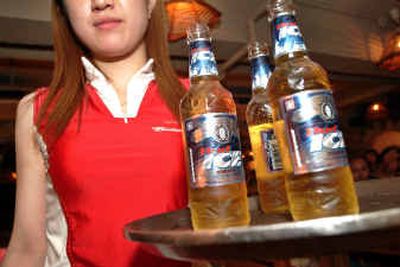A brewing beer war

SHANGHAI, China — The Bud Ice is flowing and Budweiser “beer girl” Zhen Yanting is smiling as she makes her way through Lulu’s, an upscale restaurant, encouraging diners to try her brew.
Another young woman hovers nearby, promoting Steinlager, made by New Zealand brewer Lion Nathan.
It’s another day on the front lines of the war for the world’s biggest beer market. The combatants are the world’s biggest brewers, and their foot soldiers are young women like Zhen, decked out in knee-high white vinyl boots and microminis.
In the latest skirmish, last week, Anheuser-Busch defeated SABMiller for control of Harbin Brewery Group Ltd., a century-old beer maker in the northeastern city of Harbin.
The maker of Budweiser, Bud Ice and other well-known beers grabbed a controlling 37.4 percent share in Harbin Brewery, making an automatic bid for Harbin that topped SABMiller’s offer by nearly 30 percent. The Chinese management approved the U.S. company’s offer, and London-based SABMiller bowed out, agreeing to sell its 28 percent stake to Anheuser-Busch for $211 million.
The fight over Harbin Brewery reflects the surging foreign interest in China’s beer industry, which surpassed the United States in 2002 as the world’s biggest.
Chinese beer sales are growing by more than 5 percent a year — a fast clip compared to stagnant U.S. and European markets. And the potential for growth seems huge — the average Chinese drinks just 38 pints a year, compared with 176.4 pints for Americans, according to industry estimates.
China’s beer industry was set up by German entrepreneurs a century ago, and their breweries are still the most prominent, led by Tsingtao, the country’s best-known brand abroad. Some 60 foreign beer makers have joint ventures or other investments in China, but the market is fragmented and few have prospered.
These smaller players need foreign technology and management help, said Grace Mak, an analyst for Merrill Lynch in Hong Kong.
“They need support on the technical side to improve efficiency,” Mak said.
Global companies are seeing new opportunities to buy into the Chinese market as Beijing eases limits on foreign ownership and breweries sell shares on stock markets abroad.
“We are seeing deals being done that would have been unthinkable a few years ago,” said Stephen Goodman, a lawyer specializing in mergers and acquisitions at Jones Day in Hong Kong.
Anheuser-Busch’s aggressive bid for Harbin Brewery reflects its status as China’s leading foreign brand.
“If you want to be a long-term player in the industry, you should have a strong position in China,” said Stephen Burrows, chief executive for Anheuser-Busch International.
Anheuser-Busch, the world’s biggest brewer, has a 27 percent stake in Tsingtao and owns 98 percent of the Budweiser Wuhan International Brewing Co. in the central city of Wuhan, where its Budweiser and Bud Ice brands are brewed.
SABMiller has a stake in China Resources Breweries, the country’s second biggest after Tsingtao.
From way up north in Harbin all the way to the south, Budweiser — known as “Baiwei,” or “100 Powers” in Chinese — is by far the more visible presence in China.
Anheuser-Busch has nurtured good relations with Harbin, most recently announcing plans to donate $8 million to the city’s economic development fund.
It has launched an advertising push for the thirsty summer season, plastering Shanghai subway cars with posters of red and white, dripping cold Bud bottles. Neon Budweiser signs festoon beer gardens downtown, and Bud billboards are planted in obscure local housing compounds.
Other brands also vied for attention: Carlsberg, Heineken and Tsingtao. And there was Zhen’s competitor, selling Steinlager, made by Lion Nathan at breweries in the Shanghai area.
Any bad feelings?
“Oh no,” said Zhen. “We still chat. After all, this is just work.”